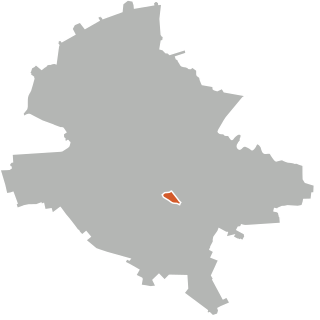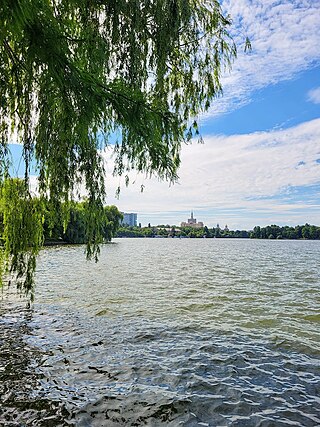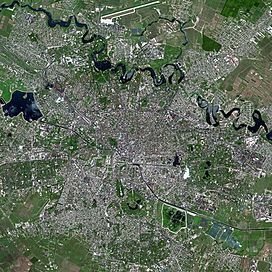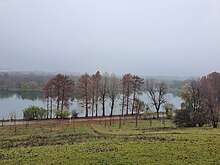
Bucharest is the capital and largest city of Romania. The metropolis stands on the River Dâmbovița in south-eastern Romania. Its population is officially estimated at 1.76 million residents within a greater metropolitan area of 2.3 million residents, which makes Bucharest the 8th most-populous city in the European Union. The city area measures 240 km2 (93 sq mi) and comprises 6 districts (Sectoare), while the metropolitan area covers 1,811 km2 (699 sq mi). Bucharest is a major cultural, political and economic hub, and the country's seat of government.

Piatra Neamț is the capital city of Neamț County, in the historical region of Western Moldavia, in northeastern Romania. Because of its very privileged location in the Eastern Carpathian mountains, it is considered one of the most picturesque cities in Romania. The Nord-Est Regional Development Agency is located in Piatra Neamț.

The Cișmigiu Gardens or Cișmigiu Park are a public park in the center of Bucharest, Romania, spanning areas on all sides of an artificial lake. The gardens' creation was an important moment in the history of Bucharest. They form the oldest and, at 14.6 hectares, the largest park in city's central area.

Constantin Brâncoveanu is a metro station in Bucharest. It is named after Constantin Brâncoveanu, a Wallachian prince (1654–1714).

King Michael I Park, formerly Herăstrău Park, is a large park on the northern side of Bucharest, Romania, around Lake Herăstrău, one of the lakes formed by the Colentina River.

The Piatra Craiului Mountains are a mountain range in the Southern Carpathians in Romania. Its name is translated as Kings' Rock or The Rock of the Prince. The mountain range is located in Brașov and Argeș counties; it is included in the Piatra Craiului National Park, which covers an area of 14,766 hectares (60 sq mi).

Nicolae Romanescu Park, known over time as the Bibescu Park, the Independence Park or the People's Park, is a park in Craiova, Romania. Located on the site of the mid-19th century estate and gardens of the Bibescu family, it was designed by the French architect Édouard Redont and constructed between 1897 and 1903. It is wrongly considered in pop culture as the largest natural park in Eastern Europe. It is actually an urban park. The park was built in a romantic style, a synthesis of landscape architecture and painting.

Carol I Park is a public park in Bucharest, Romania, named after King Carol I of Romania. A French garden located in the southern-central area of Bucharest, partly on Filaret Hill, originally capable of hosting various exhibitions, it suffered considerable modifications during the communist regime, including a name change to Parcul Libertății.

Grădina Icoanei is a small park in central Bucharest, situated not far away from Piața Romană and Bulevardul Magheru. The park, located next to Gheorghe Cantacuzino Plaza in Sector 2 of the city, was inaugurated in 1873.
Bordei Park is a small park in Sector 1 of Bucharest, in the northern part of the city. The area has a difficult history, with the status and ownership of the park having changed several times throughout the years.

Tineretului is a small neighborhood in south Bucharest, Romania in Sector 4, close to the city center, named after the nearby Tineretului Park. It is one of the preferred neighborhoods by people seeking to buy an apartment. This is due to the well established public transportation, two nearby parks; along with banks, commercial spaces and schools. In 2015 there were 17,981 people registered living in this area.

The Comana Natural Park is a protected area situated in Romania, in the administrative territory of Giurgiu County.

Văcărești Nature Park is a nature park located in Sector 4 of Bucharest, Romania, containing the wetlands surrounding Lake Văcărești.

The Botanical Park, since 2007 the Botanical Garden, is an arboretum in Timișoara. Up to its development in the 1900s, the land on which the park is located today was used as a training ground for military exercises. Much earlier, the land was supposedly the site of a Roman cemetery. In 1995 it was declared a scientific reserve, in order to protect the local and exotic flora.

Ion Creangă Children's Park is a children's park in Timișoara that bears the name of Romanian children's author Ion Creangă.

Lake Herăstrău is an anthropic lake located in the northern part of the city of Bucharest, developed on the Colentina River, in the area where it flows through the urban area of the city, situated between Lake Băneasa upstream and Lake Floreasca downstream. It is the biggest lake in Bucharest.

Lake Tineretului is an anthropic lake located in Bucharest, Sector 4, situated in Tineretului Park, covering an area of 13 hectares. The park's designer, Valentin Donose, proposed the creation of a large lake, naturally fed by the groundwater, featuring three islands, two of which are connected to the shore by small bridges. The lake is monitored by birdwatchers from Bucharest due to the presence of rare bird species that use the area for feeding or resting during migrations and winter.
Izvor Park is a public park in central Bucharest. It is located on the right bank of Dâmbovița and in close proximity to the Palace of the Parliament. it is one of the more recent parks in Romania's capital.


















